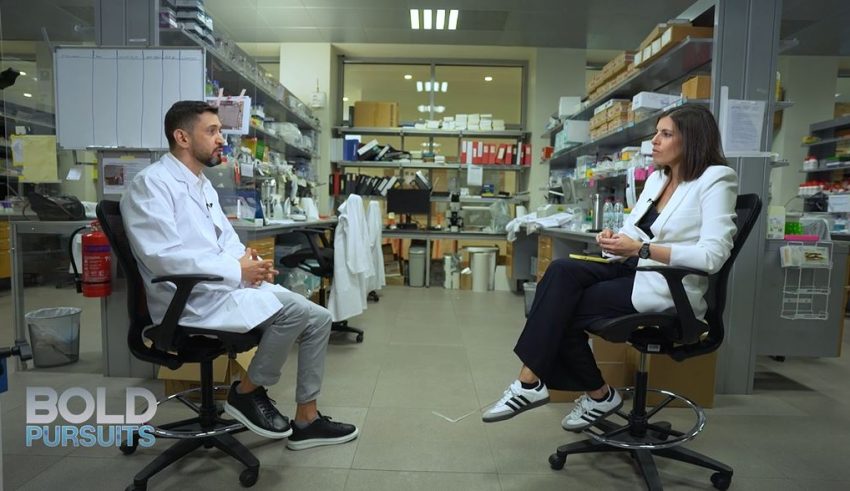
ABU DHABI: In a new series Bold Pursuits, CNN’s Christina Macfarlane visits Abu Dhabi to see how technology is being utilised in innovative ways to tackle the environmental challenges the world is facing and how the solutions being created could lead to a sustainable future for generations to come.
The first episode looks at four challenges facing the world’s oceans: from the effects of CO2 and desalination to the dangers of microplastics and overfishing.
At a mangrove sanctuary on the outskirts of Abu Dhabi, Macfarlane meets Kemal Celik, Assistant Professor of Civil and Urban Engineering at NYU Abu Dhabi. Celik is investigating new and innovative ways to make cement, a key component for the construction industry and a major environmental polluter. “We need to decarbonise the cement industry because it’s responsible for 8% of the human made CO2 emissions,” he says.
The salty water of the mangrove sanctuary goes through a process of desalination to make it drinkable. The leftover salt, called brine, is not environmentally friendly. However, Celik has been able to take the waste product and use it to create carbon-free cement alternatives. He explains, “What we are doing is using this reject brine from the desalination plant and applying very simple chemistry. We are adding cost-efficient chemicals, adding mixture, and then do stirring process and centrifugation, which means we are separating the solid to the liquid and using this solid part to make a cement.”
Many experts see the oceans as holding the key to achieving ambitious carbon neutral targets. At the University of California Los Angeles (UCLA), carbon capture technology is being used as a cutting-edge climate breakthrough. Dante Simonetti, Associate Professor, Institute for Carbon Management at UCLA speaks about the benefits, “The ocean stores approximately 150 times more carbon dioxide than the atmosphere. Our process removes carbon dioxide from the atmosphere by leveraging the power of the ocean, to naturally absorb carbon dioxide from the air.”
Simonetti describes how the process involves sea water being pumped in from the ocean, where it’s subjected to an electrical charge. Through chemical reactions the CO2 and water are separated. The CO2 now trapped in solid form is pumped back into the ocean and stored on the sea floor, and the water, which no longer has carbon dioxide, is sent back to the ocean too where it is ready to absorb more CO2 from the atmosphere, “We’re simply returning back to the ocean everything that was naturally in the ocean beforehand, but just in a form where it’s more permanently used, sequestered.”
Another challenge facing the oceans is the increase of plastic litter which over time is broken down into microplastics causing pollution and harming marine life. Sustainable clothing manufacturer DGrade are hoping to help solve this problem. Rebecca Rich, Head of Corporate Social Responsibility at DGrade, talks about their process, “What we do is take this usually fairly dirty plastic. Once it goes through the cold washing process, it then is shredded into these flakes. Then it comes out and we can use this to make our green spun yarn to make a T-shirt, for example. But we also supply it to local packaging manufacturers so they can create recycled packaging.”
Scientists in New York City are also experimenting with innovative ways to make more sustainable types of clothing. At NYC Columbia University, CNN meets Theanne Schiros, Co-Founder & Chief Science Officer at Werewool, who is creating biodegradable textile fibres that have the same properties as synthetic materials like spandex and polyester. Schiros speaks about why the fashion industry needs to act on sustainability, “The fashion industry is one of the most polluting and environmentally destructive industries globally. 10% of carbon emissions, 35% of microplastics pollution. Dyes and finishes are the second leading source of global wastewater. Over 90% of the 150 billion pieces of clothing made every year go to landfills and leach toxic chemicals that go into our groundwater.”
Finally, Macfarlane explores how date palm pits are being used to help the problem of overfishing. The pits are a leftover by-product that normally wouldn’t be used. Erin Lim, Associate Professor, Faculty of Health Sciences, Higher Colleges of Technology, has been experimenting with the product, adding it to fish feed. She says that this can be used to enhance the growth of fish, potentially leading to a reduction in the number of wild fish needing to be caught. Lim talks about how the team also believe that the date seed could provide a natural antibiotic in the fight against diseases in fish, “I’m a believer that mother nature sometimes would have solutions for us that have yet to be mined. We’ve found very good antimicrobial activity against common fish pathogens.”
Sources: Shehla Momin of Houbara Communications










